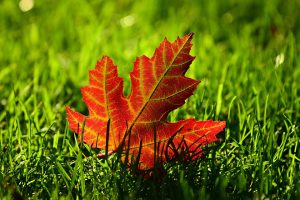Prepare Your St. Louis Lawn for Fall
 The cooler days of fall are a great time to prepare your lawn for the harsh days of winter ahead, and insure that you are the envy of the neighborhood in the spring. These tips can help you to have the lawn you have always dreamed of:
The cooler days of fall are a great time to prepare your lawn for the harsh days of winter ahead, and insure that you are the envy of the neighborhood in the spring. These tips can help you to have the lawn you have always dreamed of:
Adjust Your Mowing Height
If you raised the height of your lawn mower in summer to reduce heat stress to your lawn, return the mower deck to its normal mowing height (about 2 inches tall is best for most grasses) in fall. Cutting your lawn slightly shorter in autumn helps prevent the grass from matting down under leaves and snow. Avoid cutting the grass too short, however. Tightly clipped turf has fewer roots and allows weeds to get a foothold.
Aerate
Aeration reduces thatch, improves drainage, and loosens soil. Make sure that the aerator you use pulls plugs of soil from the turf rather than simply punching holes in the ground, which actually increases compaction over time. Aerating will increase the benefits of fertilizing and overseeing.
Fertilize in the Fall
If you want the best lawn in town, fertilize four times a year. But you can keep it simple and still have a great lawn if you only fertilize once—in the fall.
Apply the fertilizer about three weeks before the last mowing of the season. Fertilizing in the fall provides energy and nutrients for the grass roots as they multiply in cooler weather before the grass goes dormant. The roots store food for the winter as well, which gives the grass an initial growth spurt when it emerges from dormancy in the spring.
Continue to Water
Most lawns need water whenever it’s dry — no matter the season. If the fall is dry, watering once or twice per week long enough to soak the soil several inches deep is still a good idea. Avoid watering in the evening, fungus can develop in the cool, damp conditions.
Overseed
Prepare the lawn for overseeding by mowing it 1/2 inch shorter than usual and removing the clippings. Sow grass seed over the mowed area, making two passes at right angles to each other.
Overseed thin lawns or large dead areas. Keep the newly seeded sections moist while seeds sprout. Frequent light sprinklings are best at first. Gradually increase the interval between waterings to encourage the roots to grow deeper into the soil.
Remove Perennial Weeds
Dandelions, clover, and other broadleaf weeds are easy to identify in the spring, but now is the best time to rid your yard of these nuisances. Sprays work best on days with cooler temperatures and when the soil is moist.
Paying attention to your lawn this fall will help to insure that you have the best yard in the neighborhood when spring rolls around next year.
Susan Brewer Service First Real Estate (636)936-8600
Published on 2018-09-20 15:28:56

